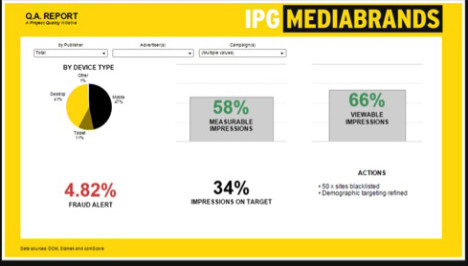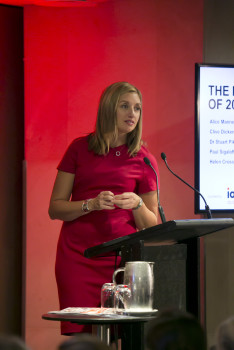IPG Mediabrands draws ‘line in the sand’ aiming for 100% viewable and fraud-free digital ads
One of Australia’s biggest advertising groups is launching a major local push on viewability and adfraud, which it hopes will help the Australian digital industry towards a consensus between publishers, agencies and clients.
IPG Mediabrands today launched “Project Quality” an Australian initiative it says is aimed at achieving 100 per cent viewable and fraud-free online advertising across its digital media bookings.
Victor Corones managing director of Magna Global, which handles the trading on IPG Mediabrands $1.47bn worth of client billings, told Mumbrella: “This is not an overnight thing. It is in the absence of industry consensus on how to tackle issues of viewability and fraud, in that void, it felt like we had to draw a line in the sand.
“Clearly we have to give confidence to clients and it is important to the vitality of the sector that if we aren’t seen to be putting strategies in place then they will start to question the value of the media.”
Project Quality has been led by Maria Grivas, head of digital for Magna Global, who argued the “time was right” to have the debate and get consensus on viewability – the amount of time an ad is in front of a consumer – before publishers can charge for it. She also said better measures needed to be taken to combat fraud issues such as bots, which create fake impressions.
Key to the Mediabrands initiative will be a client dashboard that will be given to clients and publishers to allow them to see how their campaigns are performing across key metrics including: measurable impressions, viewable impressions, fraud, and the percentage of impressions that are on target.
“We think the timing is right to really take a stance and help drive and agitate around these measures,” said Grivas.
“Why is this important? We see this as a move to measures that matter… what this does is it gives us something more tangible to latch on to. Rather than measure against arbitrary things like impressions and clicks it gives us something that is a better proxy for driving brand outcomes.”
“The fact that we are giving clients access at the same time as us means we really need to be on our game in how we are working with publishers to optimise against these measures.”
The move comes at a time when local industry body the Interactive Advertising Bureau (IAB) has said it will not trade on viewability until discrepancies and technical challenges have been addressed.
Locally IPG Mediabrands is using the latest US Media Ratings Council (MRC) standards on viewability, requiring digital ads to appear at least halfway in view for at least one second in order to count and video ads to play for two seconds to count as as a viewable impression. The group is using vendor technology from Seismic, Comscore and Integral Adscience.
“This is about sharing our thinking and how we can move this forward until there is a broader consensus. Australia is probably lagging behind those in North America who are much more progressive in this space,” said Corones.
“It is always important for an industry to have consensus. Until that point is reached it is about taking a position on how you believe the best way to navigate forward is, which is what we have done.”
“When there is something from the industry that is available then we will reassess and incorporate.”
IAB Australia has this morning welcomed the move but defended its own hesitancy to move on viewable impressions.
“The rollout of viewable impressions is a global initiative that 46 IAB’s around the world are actively involved in,” said Alice Manners CEO of IAB Australia. “In Australia we’ve provided guidelines and a framework for the market and are working closely with industry.
“While we have agreed many key points, consensus has yet to be reached due to technological challenges around monitoring viewable impressions; addressing and even the need for practical elements such as billing systems need to catch up to the changes. It’s for this reason why trading fairly on viewable impressions isn’t recommended in the Australian marketplace currently.
“While Project Quality is a welcome initiative, we would encourage others in our industry to roll up their sleeves and get involved with us as we work to address the challenges that still exist around monitoring viewable impressions.”
Grivas noted that on the tech side all of their partners were already working in the US.
“All three (Seismic, Comscore and Integral Adscience) have their methodologies vetted by the MRC and that’s our overall approach,” she said.
“From a programmatic perspective we are also actively using our own ability to blacklist sites and having Comscore deployed across every single campaign we run through Cadreon allows us to see what sites are generating bot traffic and teams are manually creating blacklists against those sites.”
Asked why they were moving outside the IAB and whether they were asking too much of local publisher Grivas noted:
“We are not going out there and suggesting there must be 100 per cent viewability,” she said. “We know that at the moment many publisher’s business and their control of inventory is not geared up to deliver that.
“That is also why the IAB has not come forward with a defined position on what they will accept from a trading perspective around viewability.
“We want to work with publishers in collaboration to see changes to those measures in campaign flight. Our teams weekly will be sharing these reports with publishers and looking to see them drive trends upwards in terms of the improvements to viewability and of course a reduction in ad fraud.”
IPG Mediabrands has been trialling Project Quality for 18 months on clients including Office Works, Coca-Cola and ING Direct and said the increase focus on combatting issues like ad fraud was achieving results.
“What we are seeing when we are seeing in our results is that it is a lot lower than expected,” said Grivas.
“Some 18 months ago we started testing some of the vendors in the space and what we have seen across that time is a dramatic reduction in the percentage of fraud being generated. I recall 18 months ago we were seeing numbers of 12 per cent of impressions being attributed to fraud now we are seeing that come down to 0.005 per cent.
“That is a huge reduction. For us part of why that benchmark is so low is because of how much we do programmatically.”
Grivas also noted that they would be presenting their model to the IAB Standards Council in the coming weeks and wanted other media agencies to join them in the digital transparency push.
“We feel that is this a good way to lead and we are presenting to the IAB Standards Council in a few weeks,” she said. “The transparency we are adopting isn’t limited to just our business and clients but to the broader marketplace.
“We would love for other agencies to adopt this approach as well. We think that if clients are educated about these measures the more they will be demanding – that can only benefit the industry.”
Asked if IPG Mediabrands would shift spend away from publishers who were not performing on these metrics Grivas said: “Absolutely if a publisher is not able to show that they are able to minimise fraud or improve viewability then they are probably publishers that we wouldn’t recommend to our clients.”
Corones added: “We are not expecting resistance on this and I think by having an ongoing conversation it will help move it into a healthier space. We have the aspiration of 100 per cent viewability and zero fraud and putting strategies underneath to get there.
Questioned on whether 100 per cent viewable and fraud-free delivery of digital media bookings was an achievable target both media agencies executives argued that it was.
“Yes I think we can but as far as ambitions go why would you want to strive for anything less?,” she said. “With what we have seen with adtech and the pace of change and what that can deliver I have confidence that 100 per cent is possible and if more change needs to happen on the publisher side to enable that, then that is probably what will get there.”
Corones added: “What we don’t know is what is around the corner. There are always going to be new challenges to overcome but the approach is tackling those challenges when they present but the approach is tackling those questions as when they present.
“It is an ongoing aspiration to achieve 100 per cent. In the current environment it possible what’s around the corner may set us back a bit but then we keep working and evolving.”
Nic Christensen








Getting to 100% would mean cutting Google and Facebook altogether. It would be brave, but you wonder what else will make the two giants actually care about the fraud issue.
User ID not verified.
No surprise that agencies are leading the charge on viewability while the publisher funded IAB does everything to hold it back.
User ID not verified.
100% viewable is an honourable goal but one that economically will ensure there is very little net benefit for the advertiser.
User ID not verified.
“trading fairly on viewable impressions isn’t recommended in the Australian marketplace currently.” – IAB are you serious??
What do you think any client in Australia thinks of this statement??
The media agencies are right on the money here.. you cant say to a client you have to pay for advertising when you cant prove if anyone actually saw it!
User ID not verified.
The iab don’t represent the interests of the advertiser remember. They serve the publisher. Hence their avoidance of the issue.
User ID not verified.
@The Truth re: “you have to pay for advertising when you cant prove if anyone actually saw it!”
this is the case for all media. there’s a big difference between someone actually seeing the ad, and someone (person) having the opportunity to see it. all reach and frequency measures across all media are based on OTS, not ACTUAL seeing – for one, because it’s almost impossible to measure actual viewing. you also need to consider what ‘viewing’ means – viewing the whole ad? the whole time it’s on air? paying attention to it? how much attention?
it’s not a black and white issue, though I would agree the IAB has a vested interest in keeping things grey and could be working on this a bit faster.
User ID not verified.
Interesting read, I’m always intrigued to understand what angle companies approach such issues. I’ll agree and say that the IAB needs to move quicker on this, the other consideration is that a stance, such as “100% view ability” or other strategies needs to be re-enforced with capability and education. The biggest challenge in the market is having the people with the right knowledge to support these types of initiatives. Moving to this type of strategy and model will inevitably see CPM’s, CPC’s and other buying method prices increase. How can the industry have confidence in announcements like this when we know: measurement is limited on some screens, there is a lack of ad tech knowledge in AU, the industry is in a state of disruption, ad tech companies are pushing “their” solution. Yes the IAB need to take an active lead, however agencies need to increase their ad tech knowledge.
User ID not verified.
If 100% viewablity is what the industry needs then lets just go back to pop ups…. 100% viewable, yet close to 100% ineffective.
The greater the viewability the better, however, too much focus is placed on the viewabilty factor and not on the engagement of the creative or placement.
If your clients want to reduce fraud, strive for increased viewability and increase performance, just buy based on engagement as the other factors become null based on this metric.
User ID not verified.
Al, I think you will find that the OMA’s MOVE is based on Likelihood-To-See (LTS) and not Opportunity-To-See (OTS), based on analysis of hundreds of hours of real-life eye-tracking data to all the various OOH formats.
User ID not verified.